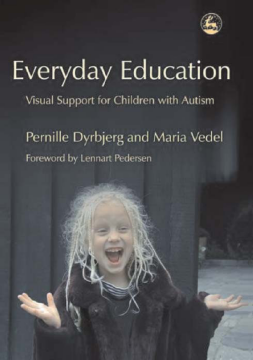
Additional Information
Book Details
Abstract
Visual support aids can be highly effective tools for increasing levels of communication and independence in children with autism, who often have difficulty interpreting spoken language and non-verbal facial expressions.
Fully illustrated with inspiring examples, Everyday Education provides a wealth of ideas for creating visual support aids for children on the autism spectrum. Photographs and clear, practical explanations describe how these tools can be arranged helpfully around the home for the child to use. The authors describe how visual support aids can be used in all kinds of everyday situations, from labelling - for example, sticking a picture of a dinner plate with a knife and fork to the chair in which the child sits at meal times - to putting together a pictorial activities schedule for the child to refer to.
This fun and encouraging book will be a valuable source of ideas for parents of children with autism and professionals working with them.
Anyone who is involved in the care of children with autism or a developmental disorder would find it extremely useful and practical guide to enable them to provide visual support for the child, especially childminders working in a home environment as the activities are simple and require little organisation or expensive resources. This book gives detailed but clear information on how to ensure that children with autism are provided with the support needed for everyday living. The language used is simple and easy to understand and there are full colours and clear photographs throughout the book which compliment the text and aid the readers understanding of what visual aids mean in context.
The final section of the book contains a list of useful contact address and relevant websites to offer further support, resources and reference as well as a number of books suitable for use with children with autism. To summarise, I feel anyone wanting to gain a quick but effective understanding of how to support children with autism through the use of visual aids would find this book a really useful and more important useable and accessible addition to their bookshelf.
National Childminding Association
Since autistic children have difficulty seeing "the big picture", and therefore focus on details, visual support aids are a vital tool for increasing communication and understanding skills, say the authors. With insights from Vedel (a hearing and speech therapist), Dyrbjerg shares with parents and caregivers the visual aids that help her autistic daughter complete her daily routine. Color photographs and brief explanations display how aids (e.g. icons, egg timers) help with hygiene and dressing routines, reduce challenges with learning new skills, assist preparation for school and mealtimes, and encourage social interaction and play. Resources for purchasing aids are included.
www.booknews.com
This is a delightful read. It describes a variety of visual aids and strategies for children with autism. The ideas would also be suitable for any child or client whi needs visual support for communication difficulties.
Royal College of Speech & Language Therapists
Pernille Dyrbjerg is the mother of Dicte, who has been diagnosed with infantile autism. She is a teacher at a specialist school for autistic children in the Copenhagen area. Maria Vedel is a hearing and speech therapist. She has worked for a number of years as an adviser for parents with autistic children and with professionals who work with autistic children. Through the years, the authors have worked together giving seminars at the Centre for Autism, Copenhagen, where they both teach.
These are my signs! Before I got my signs all I could do was cry.
Dicte, a 7-year-old with autism
Table of Contents
| Section Title | Page | Action | Price |
|---|---|---|---|
| Prelims (Contents, Boxes, Figures, Photos, Maps, Tables, Abbreviations and acronyms, Preface) | |||
| 1. Water and Sanitation - Breaking the Poverty Cycle | |||
| 2. Water and Sanitation in India | |||
| 3. Introducing Gram Vikas | |||
| 4. Initiating the RHEP | |||
| 5. Project implementation, monitoring and evaluation | |||
| 6. Programme Outcomes and Impact | |||
| 7. Financing Gram Vikas’s water and sanitation programme | |||
| 8. Generalizing the approach and scaling up | |||
| Back Matter (Endnotes, Appendices 1-3, References, Index) |
